Why propaganda is my favourite source of alpha
I was born six months after the Cuban Missile Crisis, way back in May 1963.
The 1960s were great times for the Australian economy. Unemployment was low, immigration was strong, and Australian iron ore and agricultural exports boomed. From about 1970, up until I left University in 1984, the best economic picture was firmly in the rearview mirror.
The global stresses of the Cold War, monetary crises, oil crises, proxy wars, stagflation, trade protectionism, plus high unemployment, and political chaos, made ideological warfare a feature of society. Some of that was progressive, much of it was not.
Periods of geopolitical stress elevate the black arts of propaganda, spin, deception and disinformation. In the 70's, it was broadcast television. Soon, nobody knew what was true anymore, and it showed. Good for selling spandex tights, bad for world peace.
Today the preferred engine of propaganda wars is targeted social media.
Now, not even the bots know what is true anymore.
If you spend enough time in financial markets, you will discover that truth is the most important and consistent source of alpha, but only with the benefit of hindsight.
You are unlikely to know the truth whenever knowing it matters the most.
This is the game, to unearth the truth, but not to act until it is out.
In this way, understanding the mechanism of propaganda can be a source of alpha.
Here we explore the upside of folks believing falsehoods.
The money is to be made from exploiting the waves of over or under enthusiasm. The wire is long, so jump to the last section if you are only interested in stock ideas.
The Secret Squirrel Complex
There was a time when folks spoke of the Military Industrial Complex in hushed tones of awe. This no longer seems warranted to me. Ever since the famous Last Supper, of the early 1990s, the industrial conglomerates of the US military, have been steadily consolidating, and made resolute in the task of making our post-Cold War I peace more expensive than the war.
Now that we have slipped back into Cold War II, there is a once in a generation chance to up the ante and elevate war as more remunerative than the post-Cold War I peace.
Since it churns the stomach some to know that this factor drives present geopolitics, I have resorted to a less confronting manner of discourse. I am reminded of a quote from the Hagakure text by the Samurai and Zen Buddhist priest Yamamoto Tsunetomo:
“Matters of great concern should be treated lightly.” Master Ittei commented, “Matters of small concern should be treated seriously.”
To me, perhaps not you dear reader, the architects of the present strategic dilemma are better known as the Secret Squirrel Complex.
It is a term of endearment. Adopt it, if you are willing.

When intelligent young children are threatened with nuclear annihilation, in the noble cause of ideological conflict, there is absolutely no telling how they will turn out.
I turned out like me.
I am not anti-military, since I hail from a military family. My paternal grandfather was a highly decorated professional assassin in the Great War. If you know anything at all about DNA, I inherit those attributes, and more. If my eyes were better, I could be a lethal sniper.
However, thanks to my mother, my eyesight is poor, so I became a trader instead.
I also became a scientist, and many other things besides.
Human beings are more than the sum of their parts. I have never been impressed by those who felt the urge to reduce every question to a binary. We are a whole. Take it or leave it.
My own grandfather killed scores of men, in plain sight, down his own gunsight.
Was he a bad man? Was he a good man?
Ultimately, he was both, and neither. He was simply a human being intent on survival.
For these reasons, I have never been a huge fan of the propaganda arm of the military, or the government. The Secret Squirrel Complex is the name I give to such people.
They are obsessed with whispered threats, and the need for urgent action.
It is a playful name. It is a fun name. I think it is non-threatening.
This name is the entire reason they never bother me.
Not now. They learned their lesson long ago.
How to spank a spy
I was about thirteen years old when ASIO came to visit me.
I was a precocious child, and later Julius Sumner Miller came to visit at the same address.
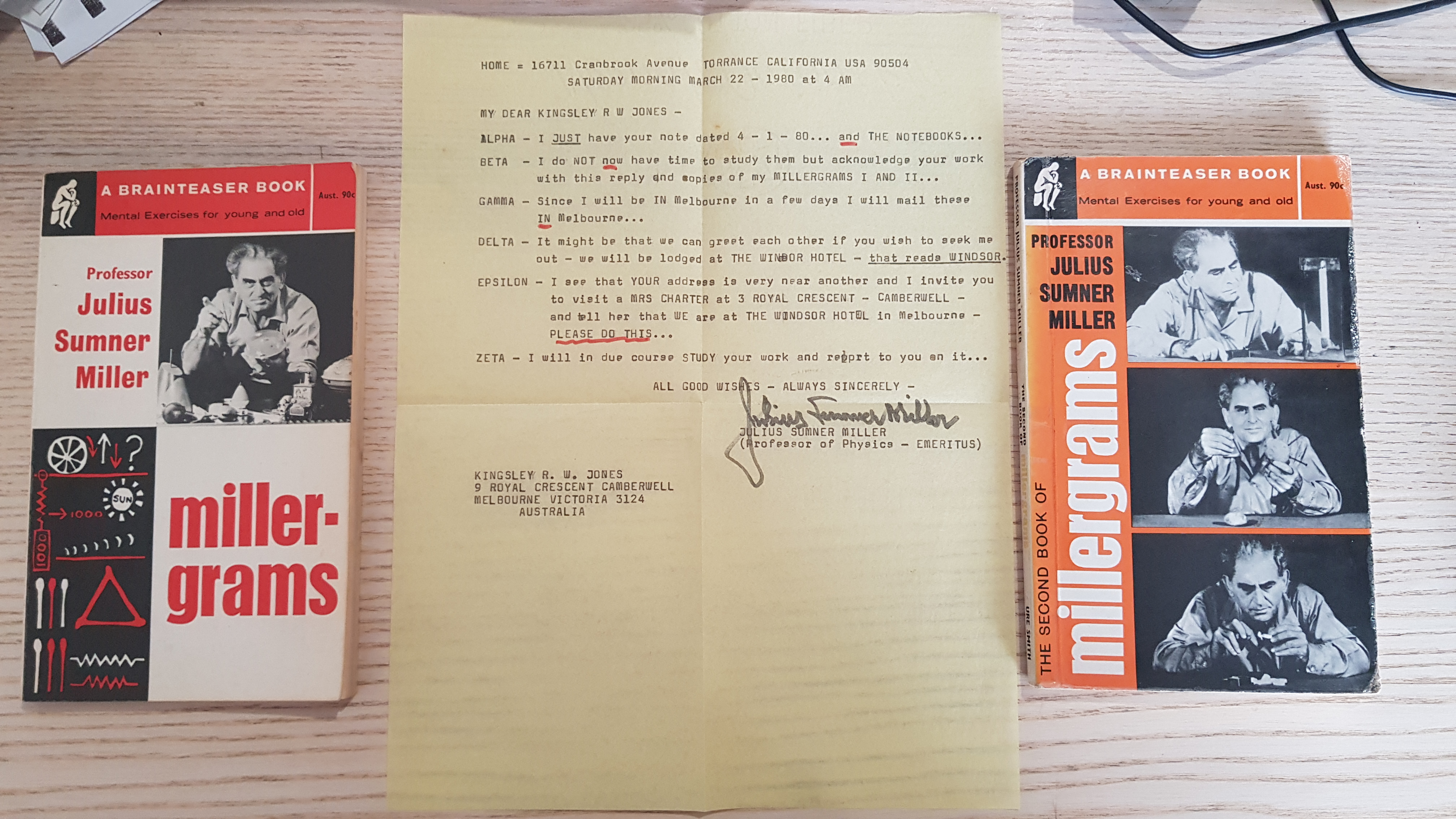
Personally, I would never have picked ASIO to visit me first, but there you go.
Spies before talent, that is the way it goes. Always.
We do know that Professor Sumner Miller was a busy man, so maybe it was a day when the folks at ASIO had nothing better to do than turn up at 9 Royal Crescent in Camberwell.
Precocious children, especially those with their own attic laboratory, need plans, blueprints and photographs of important rocket engine tests. They are not satisfied with a Funk & Wagnalls.

The primary obsession, of this child, was the space program. I was on holiday, with my parents, in Yosemite National Park, on July 20, 1969. We listened to Neil Armstrong land on the Moon, via a nine-transistor radio. I told dad that I could see them on the moon. He laughed.
When the Space Shuttle came along, I needed to know everything. Since it was the very height of the Cold War, every contractor on the program had a huge PR budget. You could just write them and ask for glossies. They would send them. It was PR on steroids.
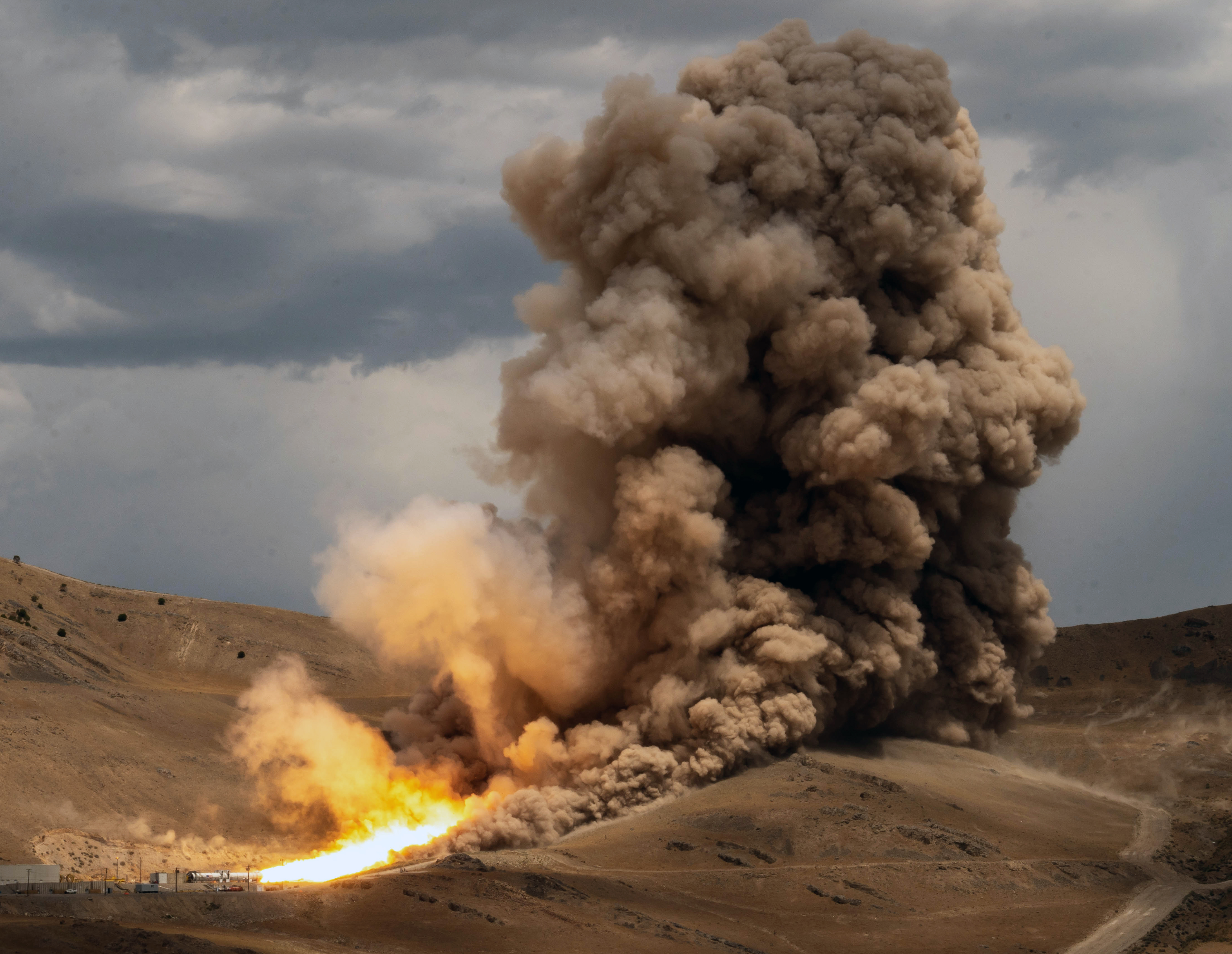
The Martin Marietta corporation duly sent me an 8x10 glossy of the very first test of the space shuttle booster rocket, the same one that blew up later. It was cool.
Around 1975, I got very interested in fighter aircraft. My favourite was the Saab Viggen. This was a Swedish designed interceptor, with short takeoff and landing (STOL) capability, impressive maneuverability, and great handling characteristics.

This aircraft was the entire reason that an unmarked black car with tinted black windows pulled up outside my suburban Melbourne house one school holiday period. A gentleman wearing a black suit, with a white shirt, and a thin black tie walked up our garden pathway.
I was upstairs, in my laboratory, conducting experiments with household current.
My mother, who was a theatre nurse, and so unphased by anything, answered the door.
"Could I please speak to Mr. Kingsley Jones?"
the mysterious stranger said.
She ushered the man into the front room, where nobody ever sits, the one which had the good furniture, and went to make him some tea, and fetch some biscuits.
On the way, she hollered:
"Kingsley, you have a visitor. A man wants to speak with you."
Frustrated at this unwelcome interruption to my scientific exploration, I tumbled down the stairs, like a herd of Wildebeest, and slouched into the front room to sit opposite him.
If he was surprised by my tender years, he did not show it, but launched into a series of probing questions. Things about my past, who I knew, and the Soviets.
I said that I did not know any Soviets. I did not find their technology to be that interesting.
Perplexed, he went on to grill me, in various ways, on the same essential topic.
"How did I know? How did I find out?"
I explained that I had taught myself calculus a year early in school, as I got bored waiting for the teacher to get to that. In short, I did not need to talk to any Soviets to learn science.
This went on, and on, with my mother smiling at this pleasant afternoon diversion.
She knew, from experience, that this mysterious stranger was in trouble.
Eventually, he relented and blurted out.
"That gunsight is Top Secret!"
Some discussion ensued; about which particular gunsight he was referring to.
Eventually, I twigged that he was talking about the Saab A37 Viggen.
"Oh, you mean the self-leveling gimballed gunsight from the Viggen?"
Bingo! I knew from his crestfallen appearance that I had hit the jackpot!
"How did you find out? Who put you up to this?"
His voice was trailing off now. I think he knew what was coming.
"Oh, I go to the Camberwell Public Library with Mum."
She corroborated my story by nodding furiously.
"They have a subscription to Aviation Week and Space Technology."
His face collapsed in a wince of pain.
"There was an advertisement for the Saab gunsight in the magazine."
His head sagged forward to seek solace in his own glimmering shoeshine.
"It looked interesting, so I wrote to the company asking for some details."
Once I said that, our mysterious stranger was in full retreat. He got up and started making excuses about needing to leave now. I was just getting warmed up. This man knew that my gunsight was Top Secret! This was very cool, so I really wanted to learn more from him.
As the man fled, I asked after him:
"Can you get me photos of the Space Shuttle main engine test?"
He mumbled something inaudible and left. He never did deliver on those photos.
Spies are like that. Interested one minute and gone the next.
Mum and I ate the biscuits over a pot of tea.
"How rude!" we muttered.
The value of Mosaic Theory for investment research
In both investment management, and military intelligence, the truth is a moving target. The idea of categorical absolutes is not very helpful. For every investment thesis, there will be a natural investment anti-thesis. Should you buy, or should you sell? How certain are you?
This topic, of how humans think, and how best to think, is as old as civilization.
The test of a first-rate intelligence is the ability to hold two opposed ideas in mind at the same time and still retain the ability to function.
Such was the view of The Great Gatsby author, F. Scott Fitzgerald, and I agree with him.
I am on the scientific record as a proponent of plausible inference via Bayesian methods. This is the area of research I specialized in during my years as a theoretical physicist. In 1991, those views were a bit controversial. They are not so now. Current practice in robotics and artificial intelligence is all founded upon a deep understanding of the power of Bayesian inference.
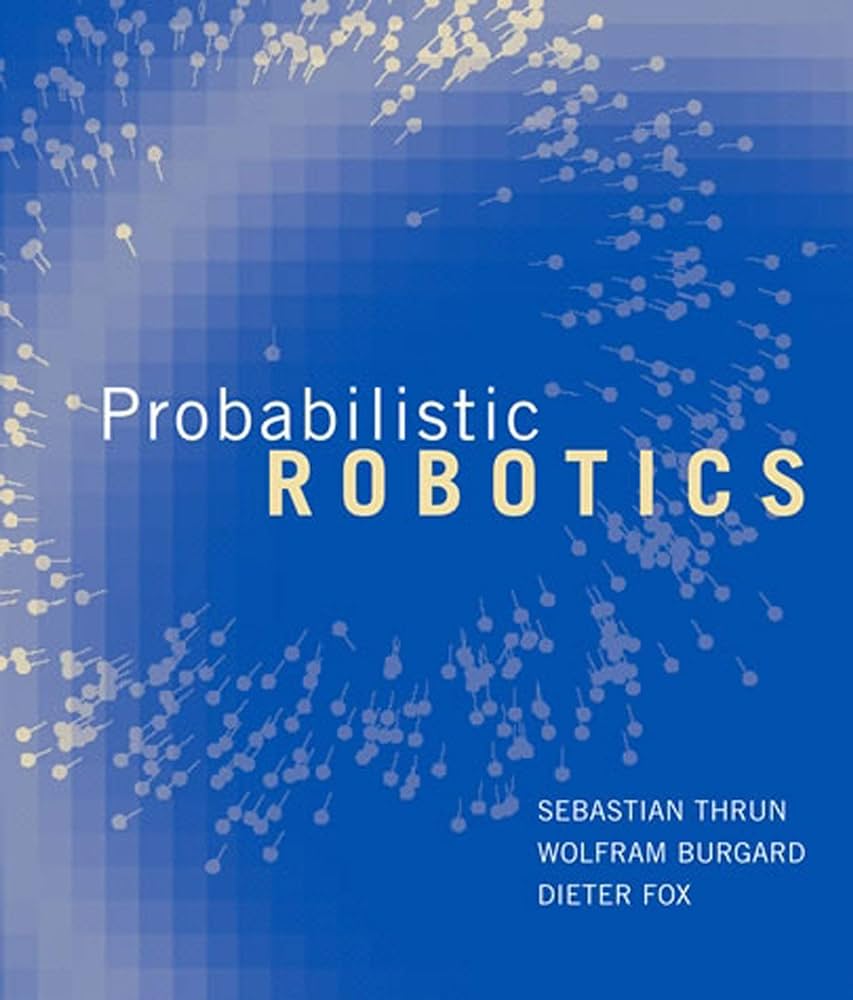
The purpose of my story, on my encounter with a real-life spy, was to emphasize how material non-public information, namely the fact that something is "Top Secret" can be learned using only plausible reasoning by piecing together non-material public information. The idiot spy may tell you it is "Top Secret", but all of the information you shared was public.
This is not like Julian Assange, and WikiLeaks. I never hacked anything. I don't need to.
Only dumb analysts need inside information.
Competent analysts construct a plausible picture of the truth, using only the assembly of what are publicly available snippets of information. Depending on what you say publicly, and how you say it, you will know you are on the right track if the company does not sue you.
This fact is so important that it features in the CFA Institute code of ethics. I quote:
The analyst may use significant conclusions derived from the analysis of public and nonmaterial nonpublic information as the basis for investment recommendations and decisions even if those conclusions would have been material inside information had they been communicated directly to the analyst by a company.
This principle is called the "Mosaic Theory" and carries weight at law.
Under the “mosaic theory,” financial analysts are free to act on this collection, or mosaic, of information without risking violation.
The ethics guidelines continue:
Investment professionals should note, however, that although analysts are free to use mosaic information in their research reports, they should save and document all their research.
This is for obvious reasons. If you cannot document how you came to discover an important piece of information, especially one the company would be disinclined to release, then you may well come under suspicion of having obtained it via illicit means.
For a public example of how to do mosaic research, see my article: Where do the separated rare earths produced by Lynas actually go? For those who are new to this, note this passage:
These are not official Lynas numbers, and I am happy to stand corrected if they represent a material misstatement of the company sales mix.
Since the company never asked me to correct them, I presume they are accurate.
In the spirit of F. Scott Fitzgerald, there are other possibilities:
- I am wrong and they don't care.
- I am wrong and they did not read the article.
- I am wrong and they are confident that other people don't care.
You can add your own possibilities and figure out their relative plausibility.
This is mosaic research at work.
You will never be certain, but you may be more correct than you thought possible. In some cases, you will be sufficiently correct to solicit a reaction, or be punished for overstating a case.
The interaction between propaganda and mosaic research principles should now be clear. Here is the Wikipedia definition of the term propaganda:
Propaganda is communication that is primarily used to influence or persuade an audience to further an agenda, which may not be objective and may be selectively presenting facts to encourage a particular synthesis or perception, or using loaded language to produce an emotional rather than a rational response to the information that is being presented.
Notice the bit about "loaded language".
This includes terms such as: autocracy, dictatorship and like-minded countries.
It should be obvious how to parse such public messaging.
Equally, you might readily parse the phrase: secret squirrel complex, as a loaded, pejorative name intended to denigrate well-meaning folks in the national security community.
Yeah, but I prefer the proper case version. It reads better. Sounds Big and Important.
Takes bow... Now, where did Mum put those left-over ASIO biscuits?

What is the main issue with the rare earth market?
I have followed the global critical minerals sector since 2010, when I first started to do work on it for Japanese prospects, while I was working for a large Australian investment bank.

If you talk to anybody who has "done time" in this area of the minerals market, they will tell you that it is chock full of disinformation and propaganda. The majority of this has to do with the geopolitics: What China did, when, to screw who, and how. There is little hard data. The very hardest thing of all to work out is this basic question:
How big is the market, and who is actually buying them?
There are mountains of research papers which all cite each other, with precious little hard data outside of that you can source from the annual USGS Mineral Commodity Summaries, or the lesser-known China Society of Rare Earths (CSRE) yearbooks.
I have a full set of those!
中国稀土学会年鉴 2002 - 2021 (That is what you need to find them on Taobao)
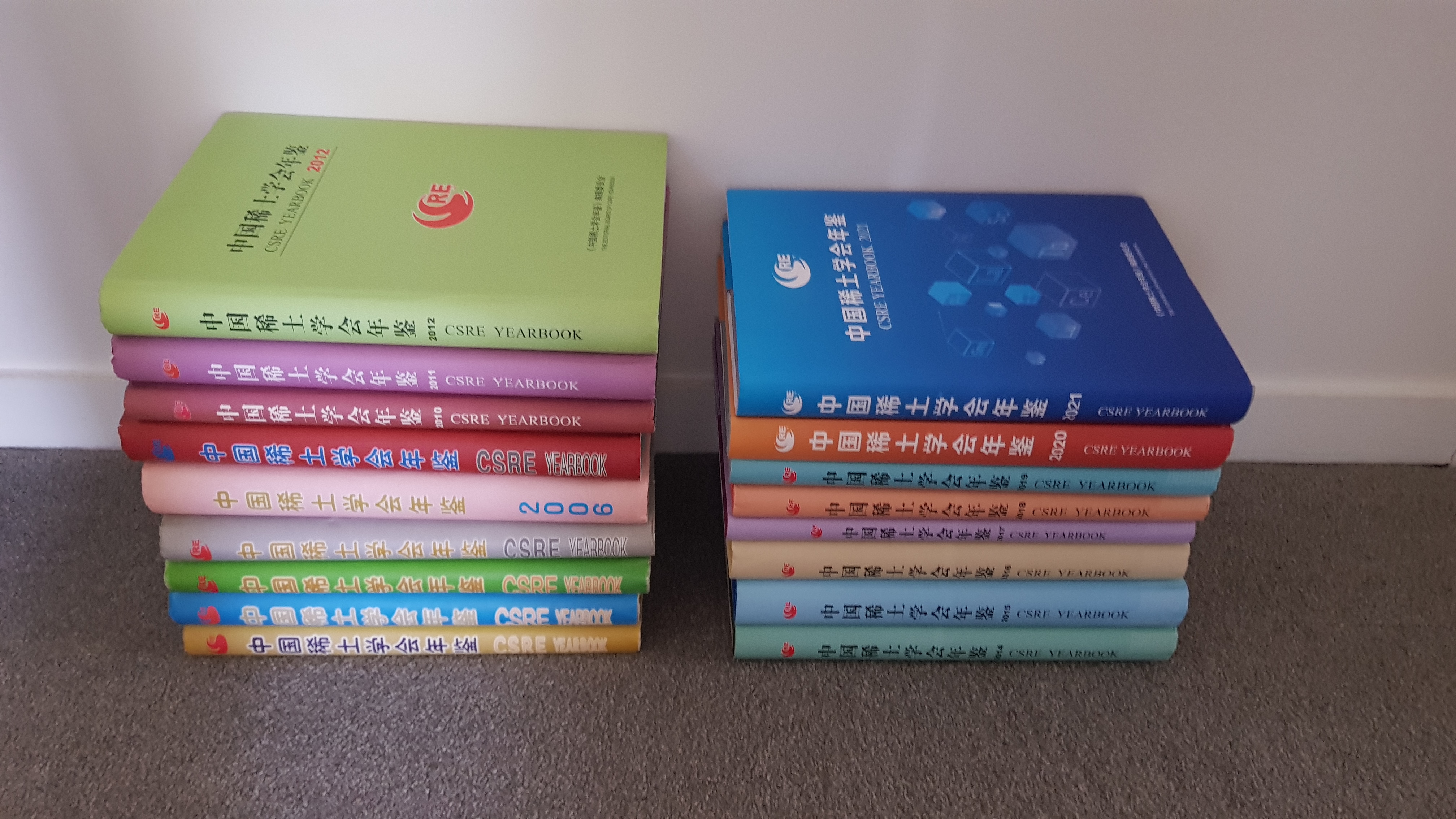
There are plenty of paid forecasters, whose numbers disagree. There are allegations of illegal mining, dodgy numbers, market manipulation and sundry shenanigans.
In such a market, it should come as no surprise that mines are hard to finance. Good luck to whichever banker can get clarity on the real buyers, and where they are.
The word crisis is synonymous with rare earths.
You cannot talk about them without mentioning the supply chain perma-crisis.
This is with us all of the time, day in and day out, but business goes on. The China market just keeps growing at about 7-8% CAGR, and nobody else will admit how little they buy.
The first propaganda balloon we punctured was the myth that the USA is desperately short of rare earths. I wrote this article: Which country is the largest exporter of unseparated rare earth concentrates to China?, to prove that the USA is the largest exporter of rare earths to China.
This was not hard, using USGS data, and SEC filings from MP Materials.
It has been public knowledge, in the industry, ever since the Mountain Pass mine restarted in 2017. However, the fact was never mentioned by local think tanks in the pay of the Australian Department of Defence, and the US State Department.
Why spoil a good crisis with facts?
I wrote about this again in my piece: The hazards of groupthink in rare earths policymaking, which covered Donald J. Trump's Executive Order (EO) of 30-Sep-2020, which claimed US critical minerals supply emergency. I won't bore you on that one.
US apparent consumption for a suite of battery minerals looks like this:
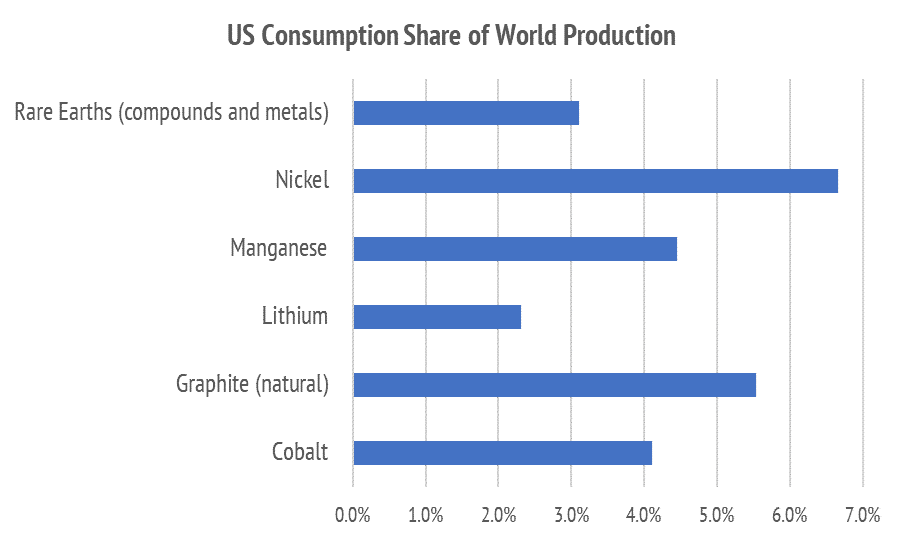
The average is 4.4% share by tonnage.
We know that the Secret Squirrel Complex think national security trumps economics. You would think that if somebody else pays your hotel bills.
Nice work if you can get it.
In the real world, miners have to pay all stakeholders from mining revenues. The USA is a great nation. Love them to bits, but check this out:

Here are two business plans for critical minerals to serve global EV demand:
- Plan A: sell only to the USA.
- Plan B: sell anywhere but the USA.
Growth investors love to speak of the total addressable market, or TAM.
The USA may be the largest economy in the world, but EV critical minerals demand is 22x smaller than the Rest of the World. On an GDP intensity of use basis, each $ of non-US GDP growth uses 7.24x more minerals.
If you do the math, the China auto market is around 25 million units per year. This is greater than the four Quad nations combined: the USA, Japan, Australia and India.
Since China commands around 60% of global EV manufacture, it has the largest chunk of mineral demand for battery minerals in general, and rare earths in particular.
A selective presentation of facts may pitch the USA as an attractive market to concentrate Australian critical minerals industry development towards, to the exclusion of China.
No amount of government sponsored propaganda will fool the investor in me.
What about military demand?
There is a widely cited Congressional Research Service (CRS) report: Rare Earth Elements in National Defense: Background, Oversight Issues, and Options for Congress. I have no issue with this report, it has some very useful information.
The need for US supply chain security in defense applications is uncontroversial.
Yes, of course!
But how much do you actually need, and, if you only need a little then why not just get on with it and build whatever mines, separation plants, and processing you might think you need?
During World War II, the USA not only designed the atomic bomb, but built every single piece of highly complex metallurgical plant and reactor capacity they needed to enrich U-235 and also create sufficient high-purity Pu-239 to build both bombs. This was at Oak Ridge, TN.
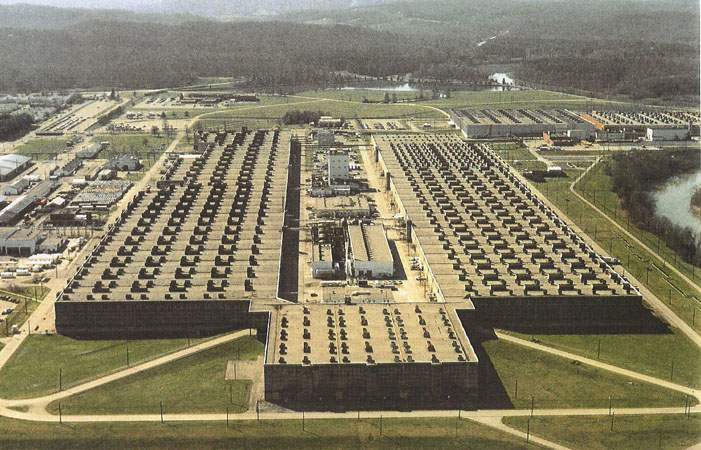
I must apologize if my next statement offends our American friends.
WTF?
If you really want this stuff, then why not just pull your finger out and get on with it?
Why must the entire Australian Critical Minerals Industry hit pause, say No! to any foreign capital that may want to build a mine, while twiddling our thumbs waiting for the band to play Stars and Stripes at the US plant opening?
It is a serious question, posed by serious investor, who is tired of Waiting for Godot.
Aside from the vexing issue of when US demand will appear, we have the related problem of defense secrecy about how much supply they actually need.
Yes, yes, we know there is critical minerals emergency. The President said so.
However, is this a piccolo emergency or a grande emergency?
Until February 24, 2022, nobody really knew. It was all idle speculation.
Then the US Department of Energy, in their Rare Earth Permanent Magnets; Supply Chain Deep Dive Assessment - U.S. Department of Energy Response to Executive Order 14017, “America’s Supply Chains", finally gave us the answer.
The US military does not need a lot. Thud.
On page 51, of the supply chain deep dive report, we find this unequivocal statement.
NdFeB requirements were assessed in the 2021 Report on Stockpile Requirements. The quantified findings of the assessment are restricted, but Figure 18 helps shed some light on key facts for NdFeB magnets required for essential civilian and military applications.
This is quite a disclosure. We are told the numbers are restricted but we can work them out from the supplementary information. We are safe because this is a public document.
Military requirements are significantly less than the capacity of even a moderate-scale NdFeB magnet plant.
Furthermore, the civilian demand is known from US Customs data. It varies from year to year, but the verifiable ballpark number is 7,000 tonnes of NdFeB magnets. From the look of the diagram below, they may have juiced that number to around 10,000 tonnes.
The typical large scale Chinese plant is around 10,000 tpa, and a moderate plant 2,000 tpa. China has many small plants of 1,000 tpa. On that basis, this report suggests that demand from the US Department of Defense is on the order of 200 to 300 tpa.
That is a very simple example of mosaic analysis. Of course, we did exactly what the DoE in the USA wanted us to do. They clearly want us to know that US Defense demand is tiny.
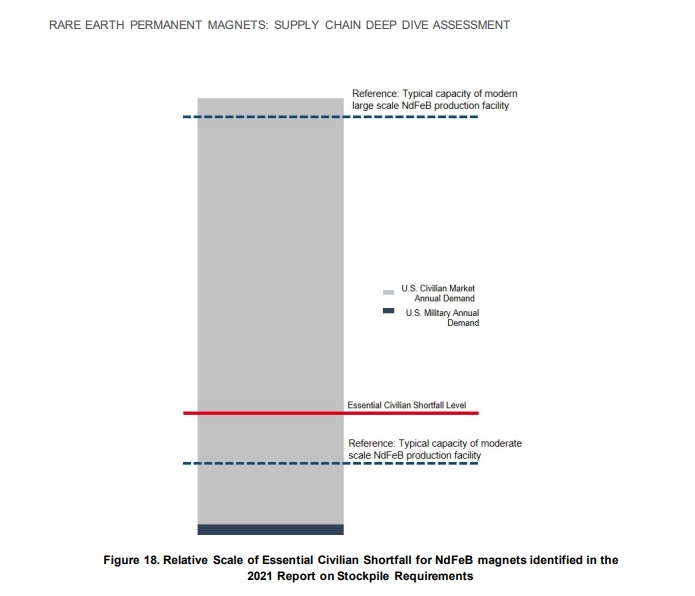
The US Defense demand is barely enough to justify one quarter of an entry level magnet plant, such as MP Materials is now building at Fort Worth in Texas.
It is a start. Lynas may actually have somebody to sell heavy rare earths to in the USA.
Where is the opportunity?
That report by the DoE in February 2022 represented real progress.
Finally, we were none of us in the dark about how minuscule US Defense Demand really is. This is a good thing. Once they have built a single plant, we can all tune out.
The propaganda ought to disappear, but then maybe it won't.
Some now advocate for rolling up the critical minerals industry into AUKUS.
Fine, if you want an industry that consumes maybe 500 tonnes per year of NdPr, spread across a bunch of like-minded militaries that don't need much.
Knock yourself out!
Attack 0.5% of the global magnet market and leave the other 99.5% to China!
Perhaps the real aim is to keep Australian Critical Minerals out of Chinese hands!
Sensible investors will then do the math on projects in Africa or Latin America. There will be plenty of Chinese capital to develop those and we can keep our Australian critical minerals in the ground, where they belong, as a national security measure to punish China.
Will it be Plan "A" or Plan "B"?
This is all too crazy for words, so let me close with some investment ideas.
Last week, I attended the second ANU Rare Earth Conference.
Those who read my posts regularly may recall my report: What I learnt from the ANU Rare Earth Conference (REECON), that summarized what I learned last year.
I was very upbeat about the Australian industry one year ago. That is because we had not heard any policy whispering about shutting out Chinese investment capital.
Since that is about 95% of possible offtake, and even more when you consider that Lynas fills a large chunk of Japanese demand, things have looked rather grim ever since.
This year, the most impactful presentation was that due to Thomas Kruemmer. He is a supply chain expert in Asia, the director of Ginger International Trade & Investment Pte., Ltd. He also publishes a widely followed substack newsletter called The Rare Earth Observer.
The presentation by Thomas was excellent and covered a wide range of material. Contained within it was one set of numbers that is very hard to come by.
I snapped that one slide.
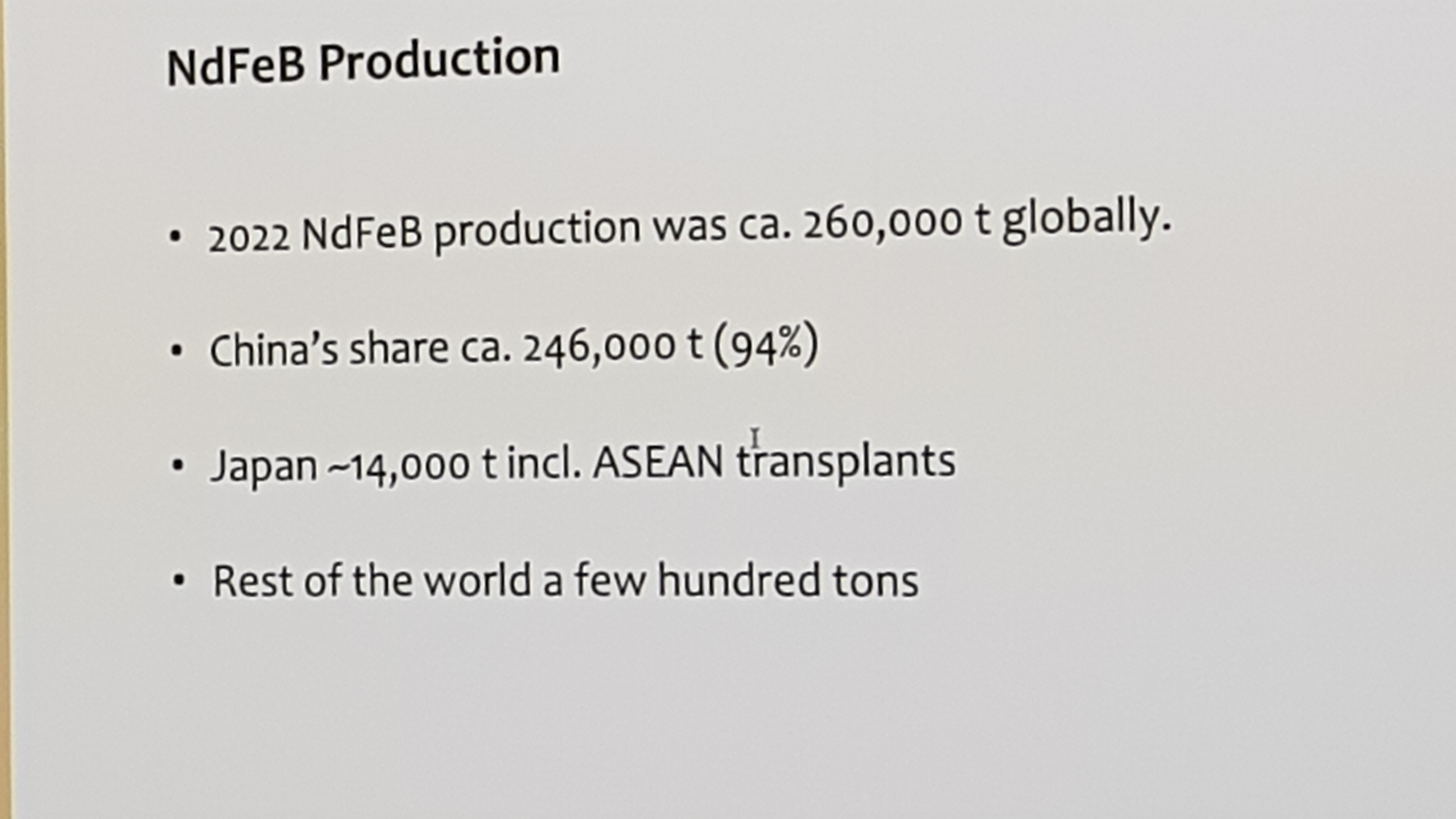
I hope Thomas does not mind me sharing this one slide of his. I think we share a common cause, educating the market, and policy makers, of this one critical fact.
Outside of China and Japan, the market for NdFeB magnet material is tiny.
This single slide from Thomas confirms what I have said to all and sundry since 2020.
There is no meaningful market for rare earth magnet materials outside of Asia.
Of course, there are plants of a few hundred tonnes utilization here and there. However, China remains the big dog, and is growing much faster. The number for total market growth in rare earth magnets, of the Neodymium-Iron-Boron (NdFeB) type is around 8% CAGR.
Japanese growth is hard to estimate, but IMARC has a forecast of 1.14% CAGR.
You read that correctly, a shade over 1% growth for Japan, and 8% growth for China.
The next day, I ran an economics workshop at the conference.
I felt compelled to include this one slide based on Thomas Kruemmer's numbers.
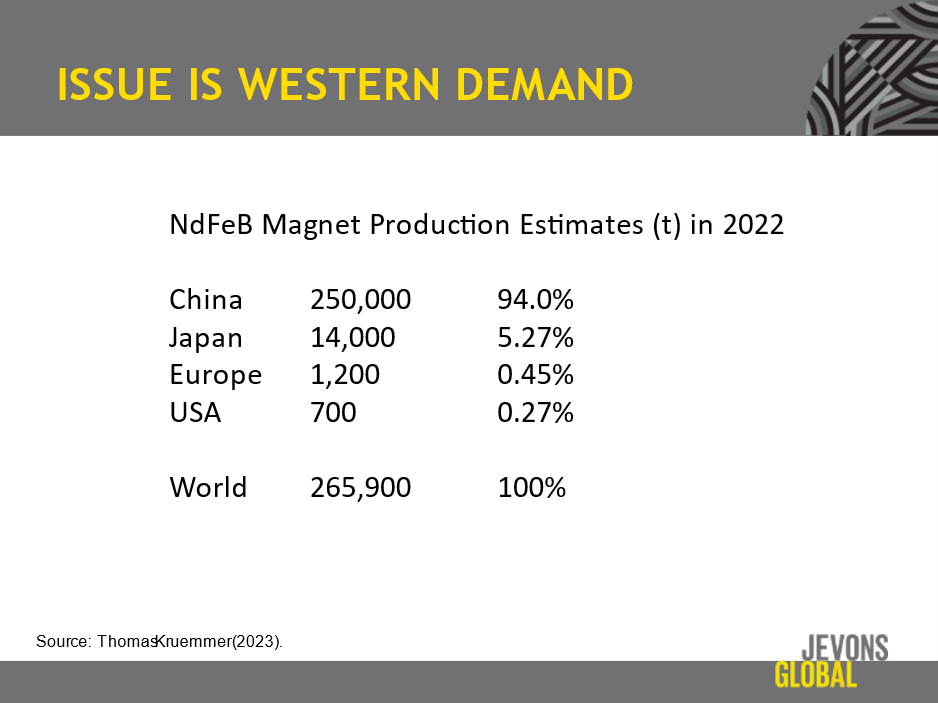
Put it this way, you have two possible business plans:
- Plan A: sell only to China.
- Plan B: sell anywhere but China.
Which do you choose? Do you choose Plan A, or Plan B?
Now consider talking to me, as a potential investor.
You are talking to someone who knows that Plan A has a 15x bigger market than Plan B and is growing at 8% CAGR. The other market has 5.3% growing at 1.1%, and the rest is aspirational.
Which plan will you choose?
How to fix the Western Rare Earth Demand Crisis
Evidently, Canberra has an industry policy bunny problem.
Every one of the latest policy whispers from the Rabbit Capital says they chose Plan B.

I am not very good at staying miserable for long, so I hatched a plan in Thomas Kruemmer's presentation. I know a little physics, and so I did some investigation.
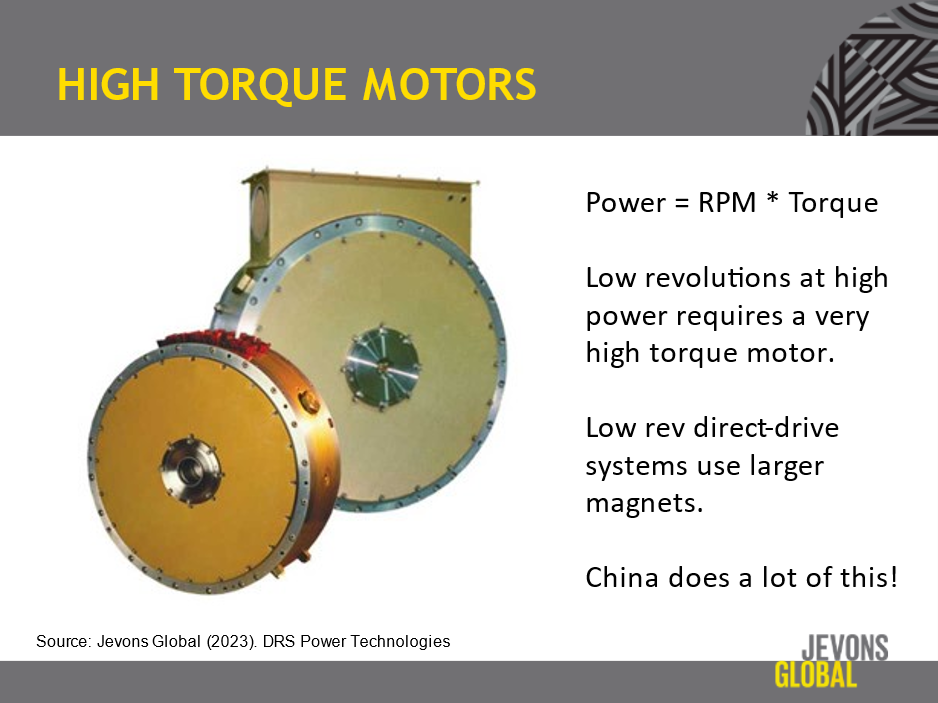
I won't go into the gory details. Torque is what you want to turn something against a load. Power is what you want to transmit to that load, or extract, for a generator.
When you have applications of equal power, but different revolutions per minute, the low rate of turn motor must have the higher torque. This is basic physics.
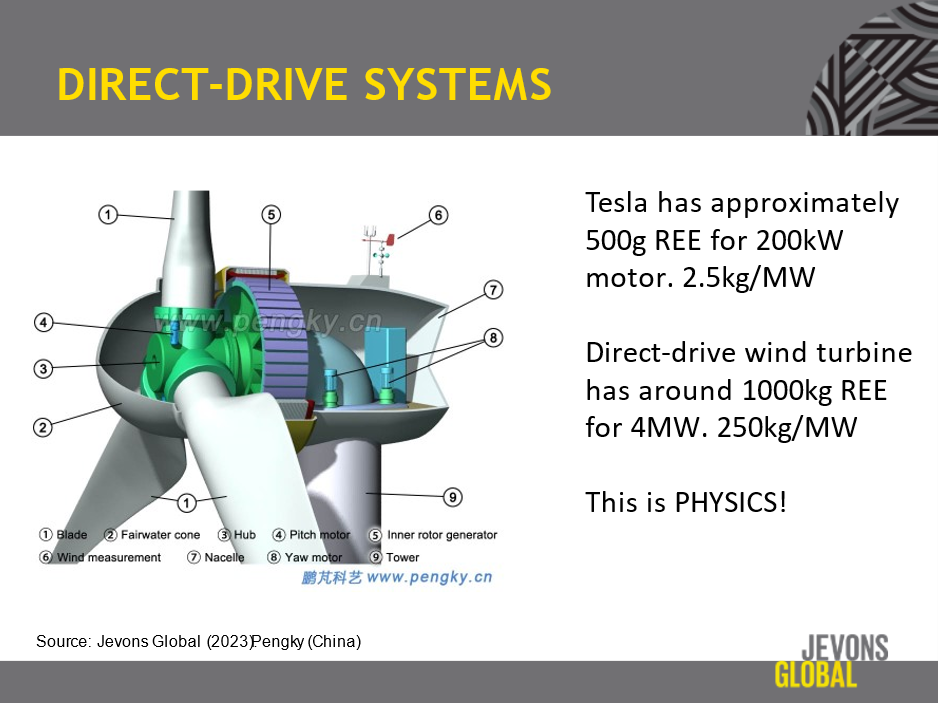
If you look at data for the amount of rare earth magnet materials consumed across different applications, you will find that the ratio is not constant, in motor or generator power. Magnets produce the magnetic force against which motor or generator windings push. Higher torque applications need more magnet material, so that the scaling is not linear.
Economists like to speak of technological advancements, but these do not come without a step change in the magnet material employed. The fact is that low-rpm, high torque, direct drive applications are intrinsically higher use per unit power for magnet material.
If you are targeting demand growth it is good to consider applications of direct-drive motors and generators that have no gear box. Offshore wind is a perfect example.
If you are targeting resource scarcity it is good to consider applications of high-speed motors, and to use a reduction gear set to amplify torque. Onshore wind is the trick.
In China, rare earths are plentiful, so they have a lot of heavy-duty direct-drive applications.
In Japan, rare earths are scarce, so they historically focused on motors for electronics.
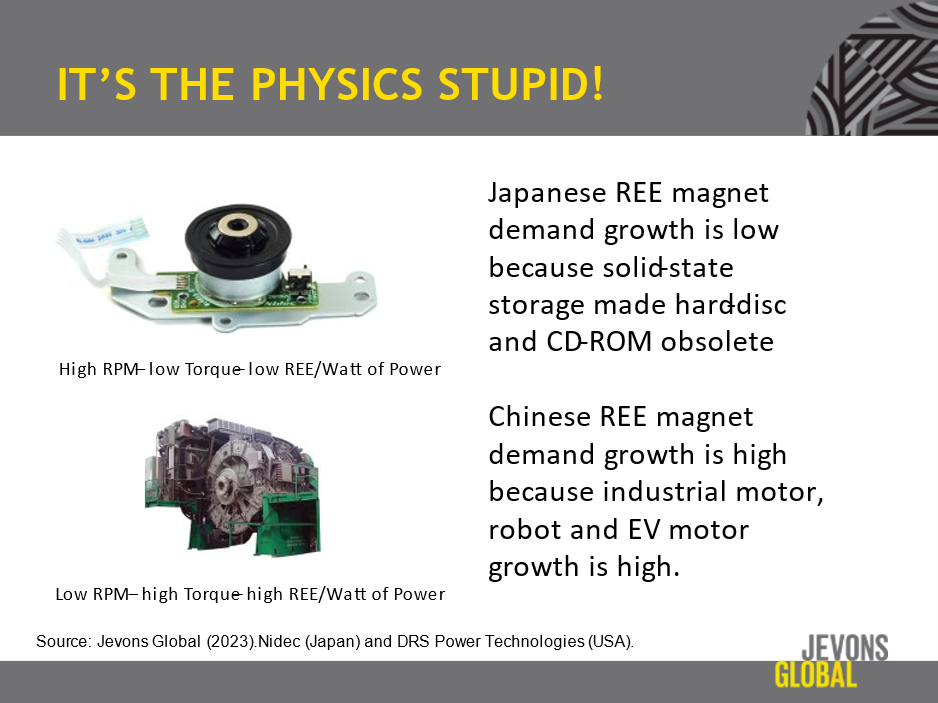
Western demand for rare earths is low due to a mentality of perma-crisis. Engineers are busy on designs that use fewer, or no, rare earths. Managers target industries that require motors and generators which are lower torque or are coupled with a gearbox reduction drive.
I don't expect policymakers to pay much attention to what I say.
However, investors should.
Engineers who know motor design could help this cause by putting some effort into working out appropriate and easy to use scaling laws for magnet usage.
If anybody with an electrical engineering degree is interested, I would like to chat.
Opportunities amid the wreckage
Australian policymakers may surprise me by changing course.
However, until they do, my investment strategy is simple.
Target incumbent producers: Lynas ASX: LYC, MP Materials NASDAQ: MP, and Iluka ASX: ILU. Target developers with offtake in non-Australian jurisdictions: Peak Rare Earths ASX: PEK. Target heavy rare earths plays that may get acquired Australian Rare Earths ASX: AR3, Ionic Resources ASX: IXR, and Meteoric ASX: MEI, ABx ASX: ABX.
Explorers with a string of targets, or a large drill target remain interesting. I like Dreadnought Resources ASX: DRE, and Lindian Resources ASX: LIN.
In my view, this market will remain soggy until the rare earth price improves on better China demand. It would likely re-rate quickly if Australian industry policy settings changed.
However, I must be straight with my readers.
I do not expect the current bunny plague in Canberra to end anytime soon.
5 topics
10 stocks mentioned

